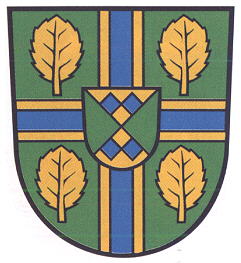Schwallungen: Difference between revisions
Jump to navigation
Jump to search
Knorrepoes (talk | contribs) m (Text replacement - "/Arms of " to "/Arms (crest) of ") |
Knorrepoes (talk | contribs) m (Text replacement - "{{media}}" to " {{de1}} {{media1}}") |
||
| Line 24: | Line 24: | ||
The escutcheon shows the arms of the former Lords Von Schwallungen, who derived their name from the village. The cross refers to the local church, which is a landmark in the reagion. The blue symbolises the Werra river. The four beech leaves symbolise the four villages in the municipality, beeches are very common in the local forests. | The escutcheon shows the arms of the former Lords Von Schwallungen, who derived their name from the village. The cross refers to the local church, which is a landmark in the reagion. The blue symbolises the Werra river. The four beech leaves symbolise the four villages in the municipality, beeches are very common in the local forests. | ||
{{ | |||
{{de1}} | |||
{{media1}} | |||
[[Civic Heraldry Literature - Germany|'''Literature''']]: Ulle, 1997. | [[Civic Heraldry Literature - Germany|'''Literature''']]: Ulle, 1997. | ||
Revision as of 11:52, 26 December 2022
This page is part of the German heraldry portal Deutsche Wappensammlung |
Heraldry of the World |
|
German heraldry:
|
Selected collector's items from Germany:
|
SCHWALLUNGEN
State : Thüringen
District (Kreis) : Schmalkalden-Meiningen
Additions : 1992 Zillbach; 1994 Eckardts, Schwarzbach
| German | In Grün ein durchgehendes golden bordiertes blaues Kreuz, belegt mit einem durch vier blaue Rauten gekoppelten von Gold und Grün Schräggevierten Herzschild, bewinkelt von vier goldenen Buchenblättem. |
| English | No blazon/translation known. Please click here to send your (heraldic !) blazon or translation |
Origin/meaning
The arms were officially granted on October 21, 1994.
The escutcheon shows the arms of the former Lords Von Schwallungen, who derived their name from the village. The cross refers to the local church, which is a landmark in the reagion. The blue symbolises the Werra river. The four beech leaves symbolise the four villages in the municipality, beeches are very common in the local forests.
Literature: Ulle, 1997.


